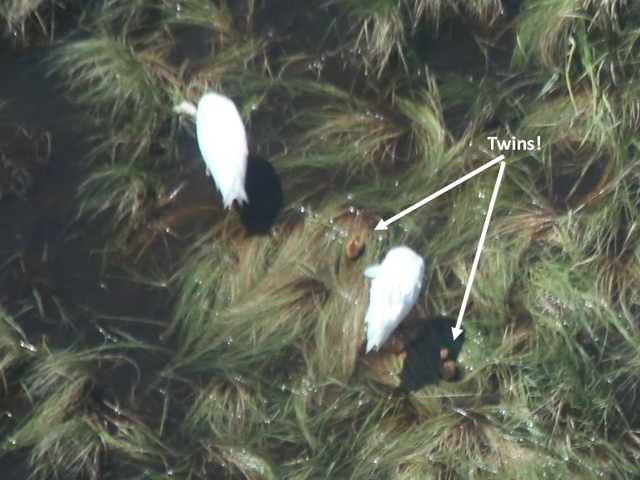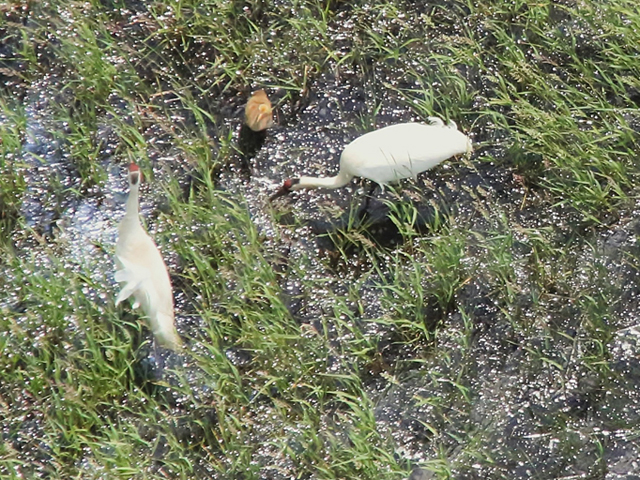|
Meet
the 2009 Whooping Crane Chicks!
Hatch-year 2009 of the Eastern Flock |
||||||||||||||
|
Crane # 925 (#25-09) |
||||||||||||||
|
Date Hatched |
May 29, 2009 |
|||||||||||||
|
Gender |
Female |
|||||||||||||
|
Egg Source |
Calgary Zoo, Canada |
|||||||||||||
Permanent (Attached after reaching Florida)
|
|
|||||||||||||
|
||||||||||||||
Personality,
Early Training
Notes from
the captive breeding "hatchery" at Patuxent WRC
in Maryland:
When 925 swam in the pool for the first time, she craned her neck all the way forward and kicked for all she was worth to reach the end of the pool. She likes swimming! She didn't do as well following the trike, and on June 12 she got extra tutoring time because she wasn’t following too well.
 |
Arrival
in Wisconsin
Photo Bev Paulan, Operation Migration |
Notes
of Flight School in Wisconsin:
She was flown to Wisconsin with Cohort #3 chicks
on July 10. Their
first training session as a group was July 15 and 925 did beautifully.
All of the chicks followed the trike and paid
no attention to one another. Chick 925 made good progress as the days
passed. She came out of the pen, followed the ultralight
eagerly, and
gobbled
up
treats when they reached the end of the runway. They
weren't flying yet but the end of July, but making progress. Go, Cohort
3! By mid August, all of cohort 3, with the exception
of 931, were starting to fly in ground effect.
 |
#925
(yellow band) runs behind the ultralight on the
verge of getting airborne!
|
Erin calls #925 a great little bird, and very curious. She soon became a good flier and good follower. She is very submissive. On health check day in September, Erin tells how #925 charmed her: I was in the pen on the side with the birds who had not yet had their health checks. Chick #925 was standing by me as I absent-mindedly dangled the sleeve of my costume, swinging it slowly back and forth like a clock pendulum. I soon noticed that curious #925 was watching and her head was swinging back and forth in perfect timing with my sleeve, like she was being hypnotized. I was glad when Bev looked our way and saw it too, and we later had a good laugh over it.
Female #925 is submissive within her cohort. After the Cohort 2 and 3 birds were joined in to one group, #925 and #914 (also submissive in her cohort), had staredowns with each other. It's as if these two submissive females were arguing about who is the most submissive!
| First Migration South: Chick #925 (and 14 others!) turned back to Necedah NWR when the Class of 2009 left on their first migration on October 16, 2009. Chicks 925 and 905 both landed back at one of the old pens on Necedah NWR. In a surprise move when the winds calmed in late afternoon, pilots Richard and Chris tried to get these two birds to follow the ultralights to join up with other chicks who had landed at a second old pen site on Necedah. The two birds did so well that the pilots kept going—all the way to the migration's first stopover site. Cranes #925 and 905 finished the day with the other five flockmates that made it to stop #1 earlier in the day.Find day-by-day news about the flock's migration and read more about #925 below. |
Oct. 27: Crane 925 dropped out of the flight to Stopover #2 and landed in a cornfield. She was "lost" until searchers on land and in the air located her. They lured her into a crate and she finished this leg of the journey in the van. Nov. 1: Hooray! 925 (and ALL the others!) flew the distance to Stopover #3. No crates needed! Nov 20: Crane 925 was one of the 16 who flew off on this exercise day and didn't come back! The 16 flew more than 15 miles before Richard located and caught up to them. He then turned them on courseand led them to safe landing at the next planned stopover. Until today, this has never happened since the pilots began leading whoopers south in 2001. January 13, 2010, Day 82: Migration complete for the "St. Marks 10:" #906, 908, 910, 911, 912, 914, 915, 918, 925, and 926! Crane 925 flew all but 12 miles of this migration! |
Spring 2010, First Journey North: Eight of the St. Marks juveniles left at mid-day March 24 on their first journey north! According to a PTT reading from #908, she (and probably #915 #910, #911, #914, #918, #925 and #926) reached Shelby County, Alabama— about 260 miles from the pen! Their next flight took them an additional 380 miles to Monroe County, IN, where an observer photo confirmed that they were all still together. As of March 29 they had flown another 73 miles to the Fountain County, IN, roughly 70 miles due east of the Piatt Co., IL stopover used during their ultralight-guided journey south last fall. Tracker Eva said a PTT reading for #915 on March 31 put them in Monroe County, Wisconsin. On April 1 Sara picked up their signals in the Necedah area. They successfully completed migration!"
 |
| Sometimes
#925 and #929 hog the feeding stations instead
of finding their own food! They've been allowed
to stay near the chicks this winter. Photo Operation Migration |
Fall 2010: Remained in Dodge County, Wisconsin at least through October 15 along with the cranes she had been with all summer and a few others. She and #908, 911, 915, 918, and 929 returned to the St. Marks NWR release site from an undetermined location on the morning of December 29. The five chicks in the Class of 2010 had already been there for several days. The older cranes came back to the pen site periodically but they picked on the smaller and younger #925 and #929. The troublemakers were driven off but the caretakers let #935 and #929 hang around the pen with the five chicks during the winter. The two were no threat to the younger birds.
Spring 2011: On March 21, the first day of spring, #925 and #929 began migration from the St. Marks pensite, taking two males (#1-10 and #8-10) from the class of 2010 with them! Data from their GPS transmitters indicated that they made it to Macon County, Alabama, nearly 200 miles to the north and right on course. GPS data from #1-10 indicates that on the night of March 24th, he had made it to Jackson County, AL in the northeast portion of the state, but it was not known if older cranes #925 and #929 and classmate #8-10 were still with him. Then, on March 30, crane #929 was detected on Necedah NWR and at Horicon NWR in Dodge County, on April 1.
Fall 2011: Crane #25-09 (formerly called #925)spent winter in Green County, Indiana, with and #18-09 (formerly called #918).
Spring 2012: Female #25-09 was reported back on Necedah NWR on March 16, with #29-09. ICF tracker Eva saw #18-09 and #25-09 with an egg May 2 but the pair never incubated the egg: No chicks for this pair in summer 2012.
Fall 2012: Female #25-09 was captured Oct. 24 and her transmitter replaced before migration. Her original band colors remain the same.
Spring 2013: Female #25-09 was reported back on Necedah NWR on March 29, with #18-09.
Fall 2013: #25-09, with mate #4-08, began migration from Necedah NWR on November 10. They were reported in Green County, Indiana on Nov. 15 and remained through at least Dec. 20 before moving to an unknown location (likely due to the extremely cold winter). They were found in Gibson County, Indiana on March 7 and moved north back into Greene County by March 21, 2014. They remained through at least March 27 before continuing north and completing migration.
Spring 2014: Female #25-09 was reported back on Necedah NWR on March 29 and mate #4-08 was with her. The pair nested and the nest was still active when checked on April 30 but failed in May when the pair parents abandoned it.
Fall 2014: Female #25-09 was now paired with male #2-04 and they didn't raise a chick this summer but on September 22, parent-reared chick #27-14 was released near the pair in hopes they would foster the chick and lead her on migration this fall. They did, and the adults and the chick left Necedahh on Oct. 31 and migrated to Hopkins County, Kentucky. They were joined there by Nov. 21 by #24-09 and 42-09, plus #1-10 and W1-06 in early December. The new family spent the winter there and the chick did well.
Spring 2015: Pair #25-09 and #2-04 departed Hopkins County, Kentucky around March 24 with their adopted youngster #27-14 and together they completed migration to Necedah NWR in Wisconsin on March 31. They were parents of new twin chicks by May 18. The adults were photographed by Wisconsin DNR pilot Bev Paulan on June 8 with surviving chick W10-15, who survived the summer and fledged.
 Photos
Beverly Paulan
Photos
Beverly Paulan

Fall 2015: The family left Necedah NWR and were reported for the first time on a wintering area in Kentucky on January 14, 2016. No chick was mentioned, and trackers are currently working on verifying the exact location and whether W10-15 is still with the parents.
Spring 2016: Crane pair #25-09 and #2-04 returned to Necedah NWR as of mid-March. Their chick, W10-15, was photographed alone in Vernon County, Wisconsin on March 26, separating from parents before the completion of the northward migration. The pair nested again and their new chick, W19-16, hatched on June 5. It was one of four surviving chicks by July 15, but had perished by July 27.
Fall 2016: Pair #25-09 and #2-04 were still in Juneau County, WI at the end of October in an unusually mild autumn. They migrated in December to Hopkins County, Kentucky.
Spring 2017: Crane pair #25-09 and #2-04 returned to Necedah NWR and were nesting by early April. They re-nested and were incubating that nest in Juneau County when seen on Beverly Paulan's May 12 aerial survey. They were still incubating as of June 5. By the June 15 aerial survey flight, they had hatched chicks W16-17 and W17-17 but neither chick survived past June 26.
 Photo
Beverly Paulan, Wisconsin DNR
Photo
Beverly Paulan, Wisconsin DNR
Last updated: 7/03/17
Back to "Meet the Flock 2009"
